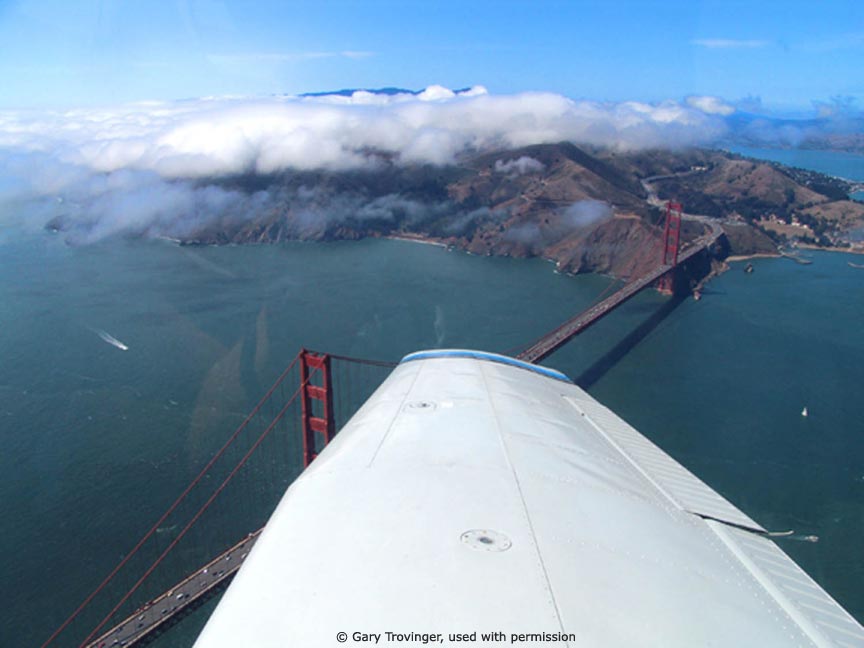Scattering Ashes by Air
Scattering the ashes of a
loved one by air is an affordable option many choose as the demand for
cremation rises. Aerial scattering offers a means of closure to
families who are ready to take the final step in the grieving process.
For some, the release of ashes into the sky by an airplane is symbolic
of manís desire to be as free as the unbridled winds. There are a
handful of companies offering the service of aerial ash scattering to
those who want a meaningful way to remember their loved oneís life.

A Meaningful Way to Remember
Aerial ash scattering is a meaningful part of the grieving process to the
families who choose this option. When the ashes are scattered over a
special place, the observing family can have a visual image permanently
ingrained in their memory. This is especially true if the event is
photographed or video taped.
Because of the uniqueness of aerial ash
scattering, families may request certain things to be incorporated into
the scattering as a way of personalizing the service. Most pilots are
able to accommodate requests that are within reason.
Some families choose to include special
hand written notes, rose pedals or other mementos to accompany the
scattering of the ashes. Others select to incorporate the actual
scattering into a memorial service simultaneously taking place on the
ground.
Many families who choose this type of
service will elect to keep a small portion of the cremated ashes and
incorporate into a small memorial such as a
keepsake urn or
cremation jewelry piece.
Earl Haskins of
Air Legacy
provides a digital photograph of the location including a time stamp.
He adds that it never fails to amaze him the satisfaction and
experience the clients relate to him.
A Specialized Service
The scattering of ashes by airplane is not as simple as it seems.
First, it is difficult if not impossible to simply open a
window and release the ashes without them blowing back into the cabin.
Gary Trovinger of Scatterings tells us of stories heís heard when, 99.9% of the time, the aircraft
would come back after the flight with the majority of the ashes
covering the occupants and the inside of the aircraft, having blown
back in as the family tried to hold the urn out the window to scatter
them.
This has lead to specialized release
systems mostly custom designed by the pilots themselves and tailored to
their individual air crafts to help facilitate the release of the
cremated ashes.
Second, not just any pilot can perform the
specialized service. It takes a pilot with a commercial license to
legally carry out the service and charge for it. Additionally,
California pilots must carry an special license allowing them to
scatter the ashes from the air or by sea for that matter.
The Last Journey
A typical mission starts with a family
filling out a contract with the company performing the aerial ash
scattering service. The customer will also provide specific
instructions for the service such as to where the ashes are to be
scattered, sometimes even providing actual coordinates.
If the customer is from out of town they will have to mail the ashes by US Postal service to the scattering company.
Once the pilot has the customerís consent
and specific directions, a flight is scheduled with all of the
necessary preparations being made. Pilots will meticulously go over
each detail to ensure the right set of ashes is scattered in the right
location. This is a very important step since the final result is
irreversible.
The day the scattering is to take place
the pilot will go through his normal pre take-off ritual ensuring all
systems are go. Once in the air the pilot will navigate to the
designated area selected by the customer for scattering and commence to
fulfill their wishes.
Since many families are unable to attend
the scattering in the cockpit, some will observe from the ground
(providing the scattering location permits this). Some pilots are able
to take a photograph capturing the scenery where the scattering
occurred, although this is highly dependent on ideal conditions. Safely
flying the plane is the pilotís first priority.
The end result has enabled families to
come to terms with their loved oneís departure. They have moved on
toward acceptance and the idea that their loved one is in a better
place. As Gary Trovinger so eloquently puts it, When the remains of
your loved one are scattered by air, each sunset becomes an ongoing
memorial, no matter where you are when that sunset is observed.
|